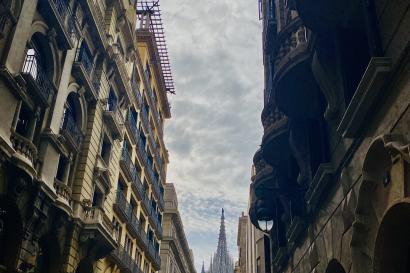
A side street in Pitigliano.
There is so much to see in Italy that its a little overwhelming trying to decide where to go. Rome, Florence, Venice – all are amazing, but what has struck me most are the quieter places. Its one thing to see the Colosseum or Ponte Vecchio, but to happen upon a small town piazza or ancient countryside castle makes Italian history feel tangible. A few weekends ago we hopped on an IES bus to a few small Tuscany towns in: Pitigliano, Sorano/Sovana and Montalcino. These are the sort of places that are not only difficult to get to without a car, but also towns I wouldn’t have necessarily chosen, or known of, myself. But after IES’s two day trip, I’m so glad I was able to visit.
The views alone from the outer ramparts of Pigitliano or Montalcino’s hilltop were worth the trip. The town of Pitigliano has been built up and inhabited since the Etruscan times, and the history shows. We toured the local synagogue, not only one of the oldest but one of the only still standing after World War II. One of the coolest parts of our Pitigliano tour: the underground tunnels and caves carved from tufo stone. Through our tour guide’s connections (a friend of a friend’s father, or something of the sort) we were taken on a walk through tunnels under one of the more ancient parts of the town. Our guide, the tunnel owner’s son, explained the tunnels had been used for all manner of things over the years, from a simple passageway to a water cistern and firearms hideaway. At one point a cavernous room gave way to a crawl space hacked into the stone: a friend crawled through and was able to clamber up what was left of the long buried steps of an ancient watch tower. The rest of the tunnels and rooms were filled with the local family’s collection of Pitigliano artifacts. We saw everything from cannonballs and farm equipment to mandolins and an 18th century ambulance. But my favorite by far was the antique film projector, from 1913. Filled with cobwebs and barely lit, it was sort of our an Italian-version Indian Jones trek, though minus booby traps and followed by a pasta lunch.
What I least expected was for our IES group to stay a country resort: mini-villas, warm hot springs, and all in Sorano (are these Italian trips spoiling us?). The next day we saw the old Sorano fortress (complete with our favorite camp games in the courtyard, of course) before moving to Montalcino and the nearby Sant’Antimo Abbey. The Abbey had the sort of sculpture and architecture I expect from Arthurian legends, fitting for an Abbey supposedly built by Charlemange. And finally we stopped at the Fanti winery (spoiled, again) for a tour and wine tasting. But, though all the tours and guides were great, perhaps the most amazing mental snapshot of the trip is our view of Tuscany from Montalcino. One of our professors told us that the view from a Montalcino park is sometimes called “the bench of Italy”. On a clear day, so it goes, you can see all the way to Siena in one direction and to the mountains of Southern Italy in the other, the beautiful Val D’Orcia before you. This is Tuscany.

My favorite find on our tour of the tunnels and rooms, carved into the tufo stone, under Pitigliano: a movie projector from 1913.

View of the countryside from Abbazia Sant’Antimo. According to legend, Charlemange built this Abbey before his return to France.

View from the Montalcino park, or the “Bench of Italy”.

A park atop Montalcino. Almost anywhere in this town had amazing views – our professor told us it was originally a fortress, hence being on a hilltop.

Tour of the Fanti winery.

Caeli Smith
<div> </div>
<div><span style="color: rgb(29, 29, 29); font-family: Arial, Verdana, sans-serif; font-size: 12px; line-height: normal; background-color: rgb(237, 237, 237);">Caeli Smith is a junior at Connecticut College and majors in English and Art with a minor in Italian and is part of an international studies program. She likes nothing more than heading out on a travel adventure - to sightsee, try new food, wander, and get a little bit lost.</span></div>











